DM Technology DM-AV10 DIGITAL PRESENTATION DEVICE User Manual DMTECH PORTABLE cover ENG
DM Technology Co., Ltd. DIGITAL PRESENTATION DEVICE DMTECH PORTABLE cover ENG
Contents
- 1. USERS MANUAL 1
- 2. USERS MANUAL 2
USERS MANUAL 2
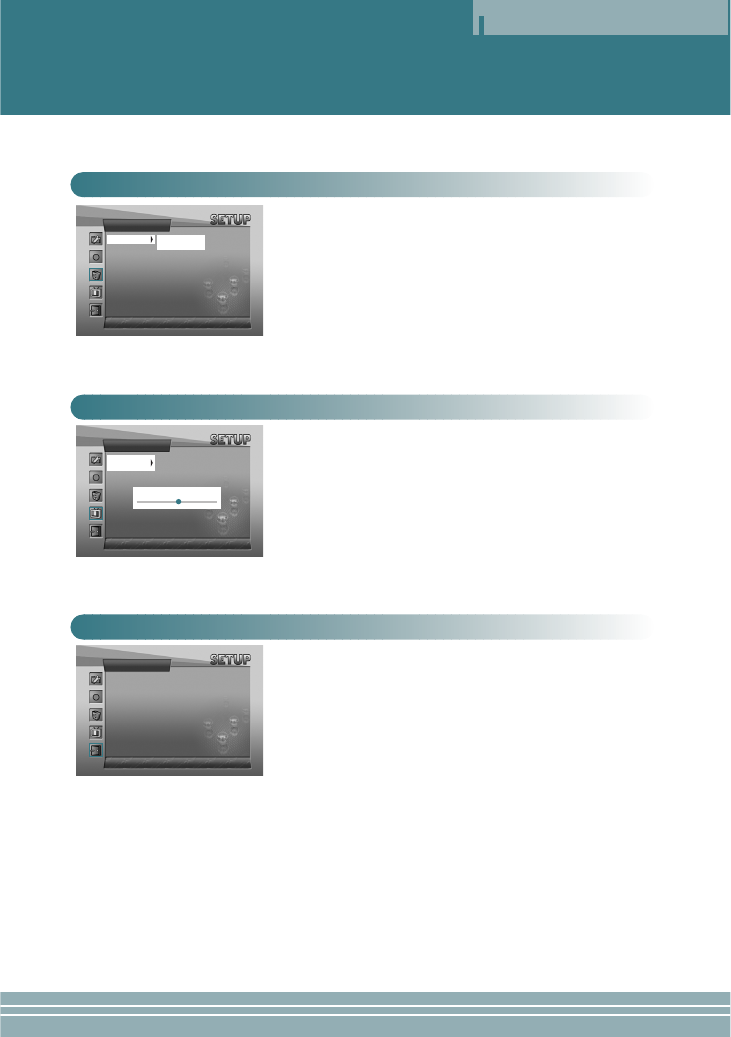
Using a Setup Menu
Operation
12
• FORMAT
INTERNAL: Use to delete all the files in the built-in memory.
EXTENDED: Use to delete all the files in the external SD card.
MEMORY FORMAT
• BRIGHTNESS
Use to adjust the brightness of the LCD window.
• CONTRAST
Use to adjust the sharpness of the LCD window.
PICTURE SETUP
The Setup menu will disappear and the menu screen will be dis-
played.
SETUP EXIT
SETUP EXIT
PICTURE
✓BRIGHTNESS
CONTRAST
LCD BRIGHTNESS SETUP
MEMORY FORMAT
✓FORMAT ✓INTERNAL
EXTENDED
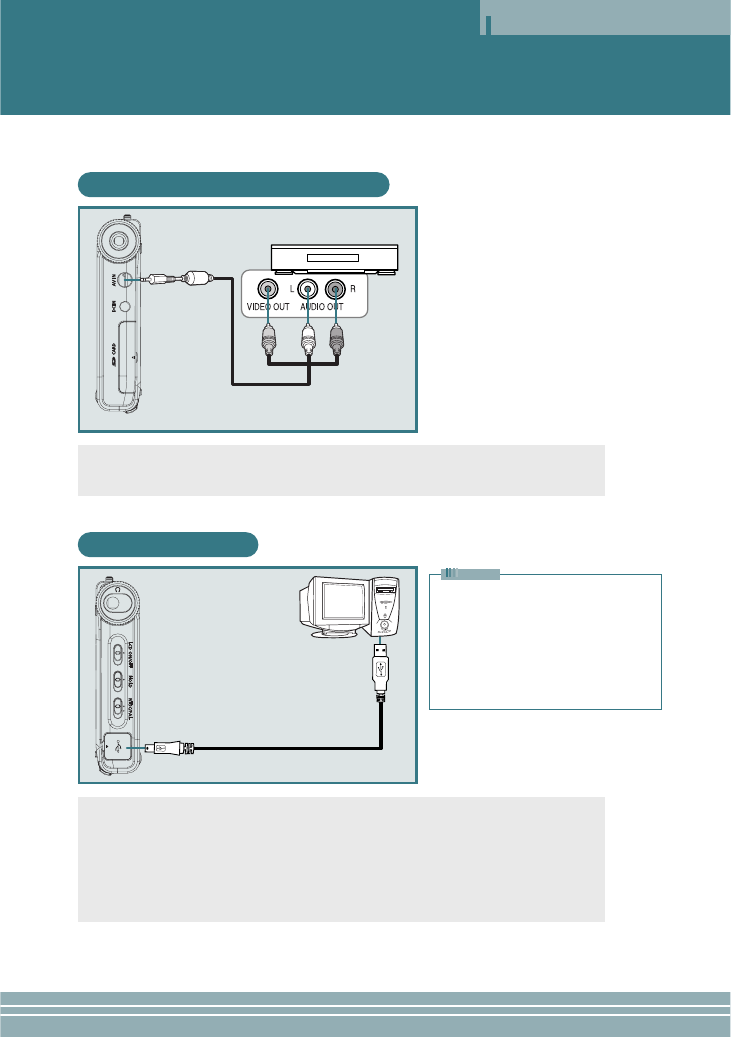
Connecting an External Component and USB
Connection
13
Connecting an AV Component
• Connect a Video/Audio cable between the A/V component (DVD/VCR) and the player.
• Connect an USB cable between a PC (Windows ME, Windows 2000, Windows XP) and
the player.
• Enter Windows Explorer after USB is recognized by the PC.
• This player is displayed as a portable disc in the list of folders of Windows Explorer.
• Methods of copying or deleting a file with a portable disc are same with the using meth-
ods in Windows.
A/V component (DVD/VCR)Right side of the player
Video/Audio cable
Connecting USB
PC
Left side of the player
USB cable
• When moving, copying, or deleting a
file through USB, remove the USB
after making sure that the USB con-
nection message window disap-
pears. During the connection of
USB, all the buttons on this player do
not operate.
Note

Installing and Using Transcoder
Installing and Using Transcoder
14
Using Environment
[PC requirements]
• Pentium III 500 MHz at least
• Memory: 256MB at least
• Microsoft DirectX supported VGA
• Sound card-required
[OS]
• Microsoft Windows ME/Windows 2000/Windows XP
[Codec]
• Divx 5.1.1, Divx 4.01, Divx 4.11, or Divx 4.12
Visit at the web site
http://www.divx.com/divx/?src=toptab_divx_from_/index.php
and download the Standard Divx codec for installation.
• DivxG400 or DirectVobSub
• Combined codec for the execution of media files
[Others]
• Microsoft DirectX 8.0 at least
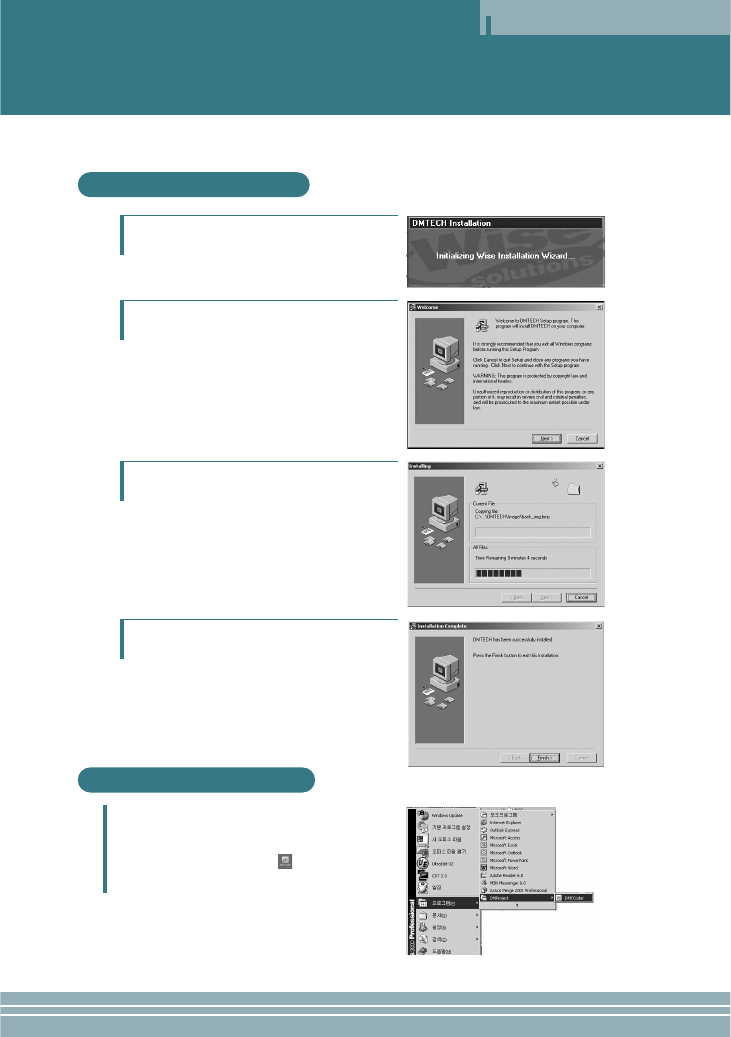
Installing and Using Transcoder
15
Installing Transcoder
Executing Transcoder
Insert the supplied installation CD and execute
"DMTransCoder.EXE".
1
Select "Next".
2
As shown in the figure right, the process of pro-
gram installation is displayed.
3
After installation is complete, select "Finish" to
end installation.
4
Select the menus at the right bottom of Windows
in the following sequence: "Start" → "Program
(P)" → "DMProject" →"DMTCoder".
Or double click "DMTCoder( )" on the
Windows background screen.
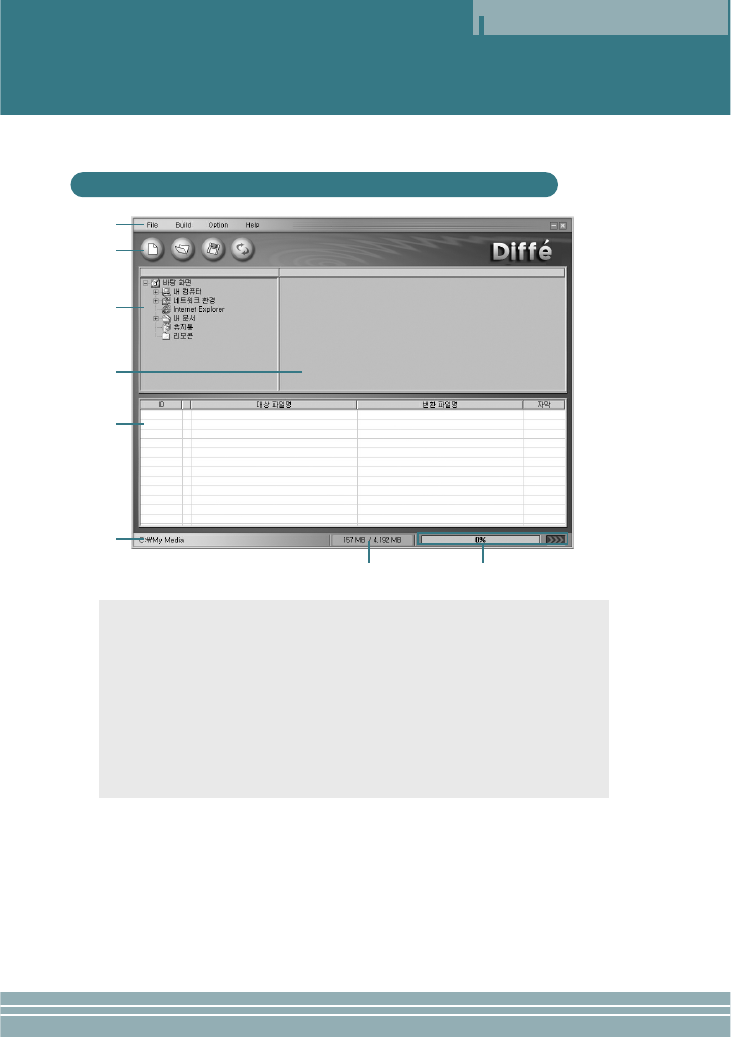
Installing and Using Transcoder
Installing and Using Transcoder
16
Configuration and Function of Transcoder Screen
ŒŒ
´´
ˇˇ
ˆˆ
ØØ
∏∏””
¨¨
ŒŒMenu
´´Function icon
ˇˇFile search window: This has the same function as Windows Explorer.
¨¨File list window: This has the same function as Windows Explorer.
ˆˆTranscoded files list window: The files to be transcoded are displayed.
ØØLocation where the transcoded files are saved: This displays the location where
the transcoded files are saved.
∏∏Capacitance of memory: This displays the capacitance of the location where the
transcoded files are saved.
””Display of transcoding progress: This displays the progress rate.
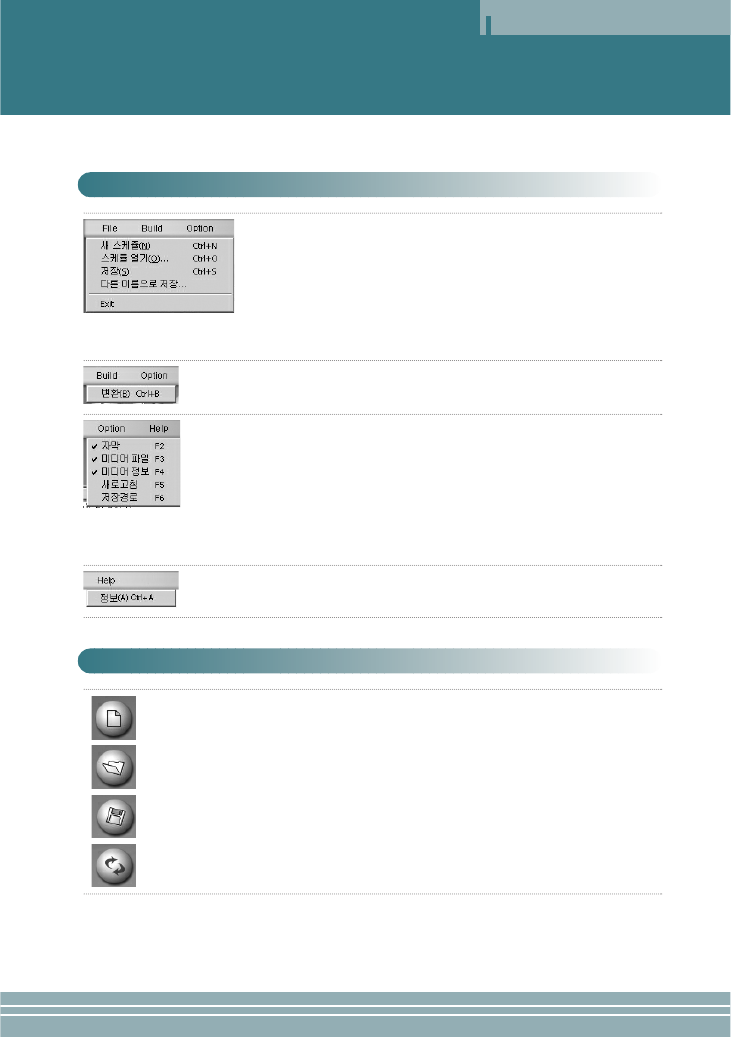
Installing and Using Transcoder
17
• File
- New schedule: Calls a new file in the list of transcoded files.
- Open schedule: Applies the saved *dmt files in the list of transcoded
files.
- Save: Saves the contents of the operation which is under progress.
in the list of transcoded files.
- Save As: Saves as another name.
- Exit: Exits the program.
• Build
- Starts transcoding.
• Option
- Caption: If there is a caption file, whether to apply or not will be
determined.
- Media file: Only media files are applied in the list.
- Media Info: Displays the files which can play without change.
This is not available in any version after Windows XP.
- Return: Re-applies the file.
- Saving path: Applies the path of a file to be transcoded.
• Help
- - Guides product information and the whole web site.
Menu
- New schedule: Builds a new list of transcoded files.
- Open schedule: Calls a list of saved transcoded files.
- Save: Saves the contents of the list of transcoded files under operation.
- Start File Switching: Starts the schedule which is applied to the list of
transcoded files.
Tool Bar
New schedule
Open schedule
Save
Start File
Switching
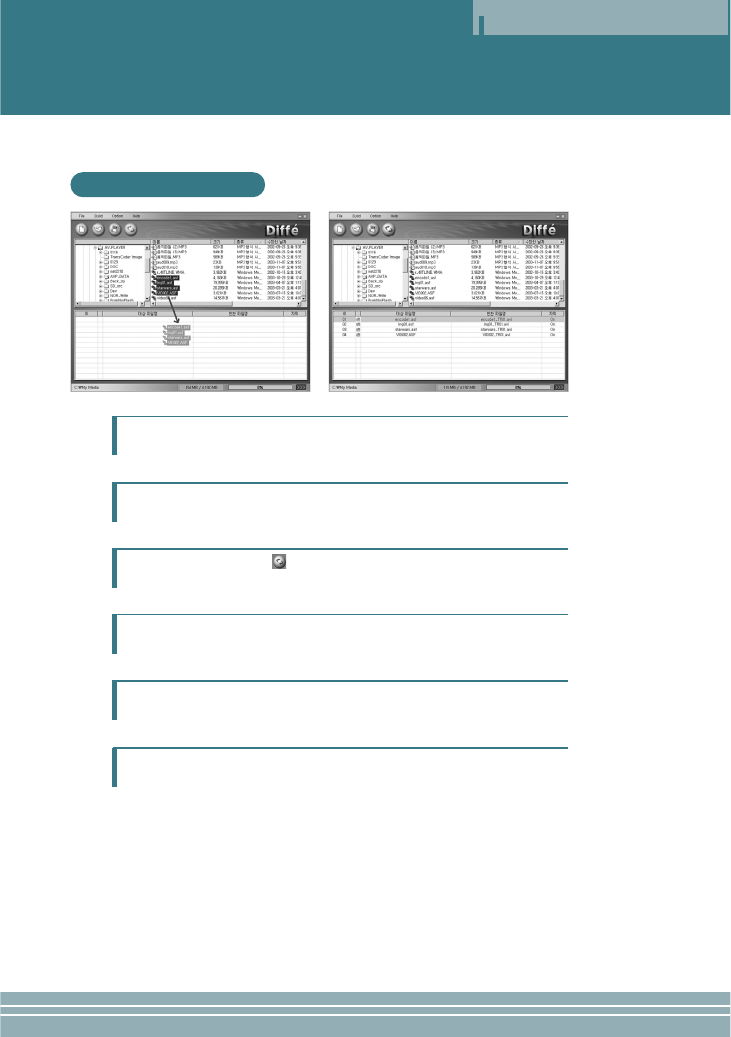
Installing and Using Transcoder
Installing and Using Transcoder
18
Transcoding files
Select the location where has a file to be transcoded in the File Search window.
1
Drag a file to be transcoded in the File List window and move it into the
Transcoded Files List window.
Select the "Transcoding ( )" function icon for execution.
2
3
The cursor in blue will be located on the file under transcoding and transcoding
will proceed.
4
After transcoding is complete, the transcoded file will be saved in the specified
location.The default folder is "C:\My Media".
5
The transcoded file can play by downloading it with a portable disc.
6

Installing and Using Transcoder
19
Note
• If Codec does not exist, the player will notice you through a message window.The message win-
dow disappears three seconds later and an icon in red appears on the list.
• If the saving space is not enough, the player will notice you through a message window.The mes-
sage window disappears three seconds later and an icon in red appears on the list.
• If Caption does not exist, the player will operate without caption.
• If any version after Windows XP is used, the menu on media information cannot be used.
(The function is not supplied by MS.)
• DivX Codec can be installed only after the user downloads Freeware.
• If Inter Video Sound Codec has been installed, the player may not play normally.
• Select either DirectVobSub or DivXG400 as a caption filter. (DirectVobSub is recommended)

20
Miscellaneous
Miscellaneous
Battery and Power
• Since this player adopts an exclusive lithium icon battery, it can charge itself and buff itself speedi-
ly within about two hours while it is completely discharged.
• When video plays while the player is buffed, the player can keep playing for about two hours.
When only MP3 plays, the player can keep playing for about four hours.
• Depending on the user's convenience, the player can be charged by using a USB cable or adap-
tor.
- Charging with a USB cable
Connect a USB cable between a PC and the player.Then the player will be charged automati-
cally while it is turned off.
Note:The charge indication lamp lights on only during charging. After charging is complete, the
lamp lights off.
- Charging with an AC adaptor
The player can be charged with a AC adaptor included in the player.
Note: Even though the player is turned off, charging will continue.
The charge indication lamp lights on only during charging. After charging is complete, the lamp
lights off.
Cautions on use
• There may be abnormality in a saved file when removing USB after the PC USB downloading
operation is complete. Remove it safely after making sure that the message "USB CONNECTED
FILE COPY" disappears.
• Be careful that an AC adaptor is not connected to the AV IN jack.
• While playing a file in the external memory, do not remove the external memory forcedly.
• This player supports USB2.0. If PC environment is USB1.1, however, this player will operate in
USB1.1.
• When connecting USB, the operation of this player will be limited.
• Do not remove a battery forcedly during playback or recording.
• When charging the player with USB, turn it off first.
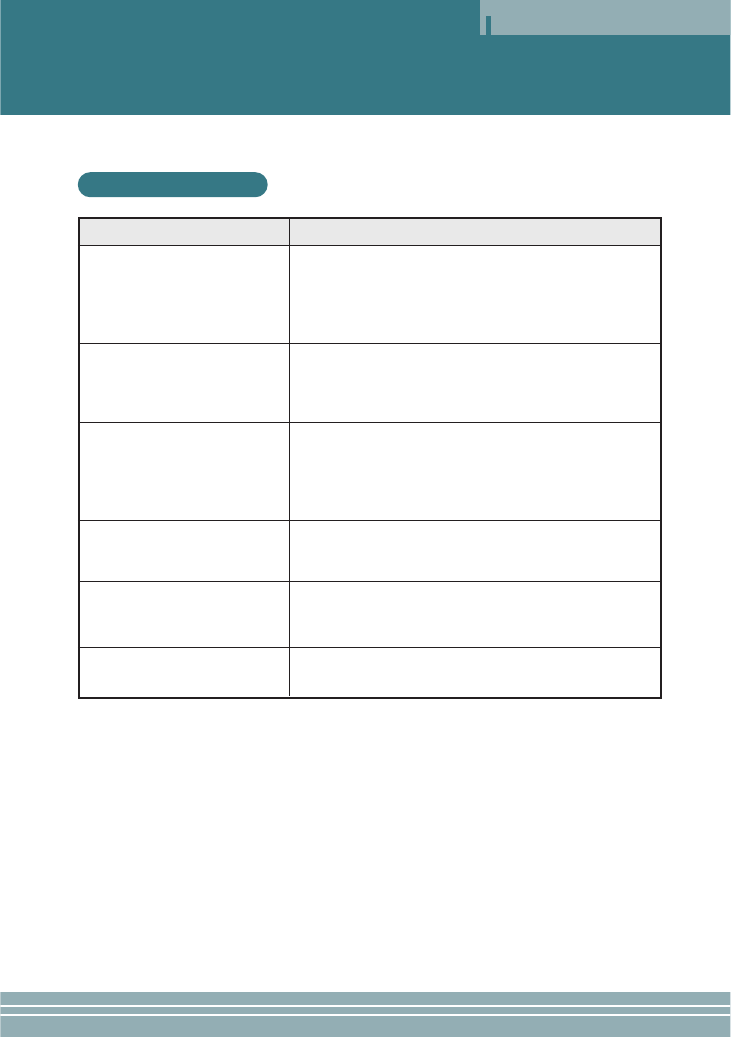
21
Miscellaneous
Troubleshooting
Symptom
The player is not turned on
When connecting an A/V cable,
the playback screen of an exter-
nal component is not displayed
normally
Earphone volume is not output
normally.
Charging does not work or the
charge indication lamp does not
light on.
An external memory (SD card) is
not recognized normally.
A downloaded moving image file
does not play
Solution
1. Check a battery or AC adaptor is installed
2. Check the battery is worn out. If so, charge it with an AC adap-
tor or USB cable.
3. Check the HOLD key or LCD OFF key is turned on.
4. Press the POWER button.
1. Check an A/V cable is properly connected.
2. If the screen is biased upper or lower, check for the broadcast-
ing system (NTSC or PAL)
1. Check for the level of volume.
2. Check for the connection of the earphone. (If there is a dirt or
foreign material in the terminal, noise may occur.)
3. If the data of the file which is playing is damaged, noise may
occur or sound may be interrupted. Check with another file.
1. Check for the connection of an AC adaptor.
2. Check for the installation of a battery.
3. Check whether the player is buffed or not.
1. Check for the installation of an external memory.
2. Check for the WRITE PROTECT switch of an SD card.
3. This player supports only “FAT and FAT16” formats.
Play the moving image file after transcoding it through the includ-
ed TRANSCODER PROGRAM.
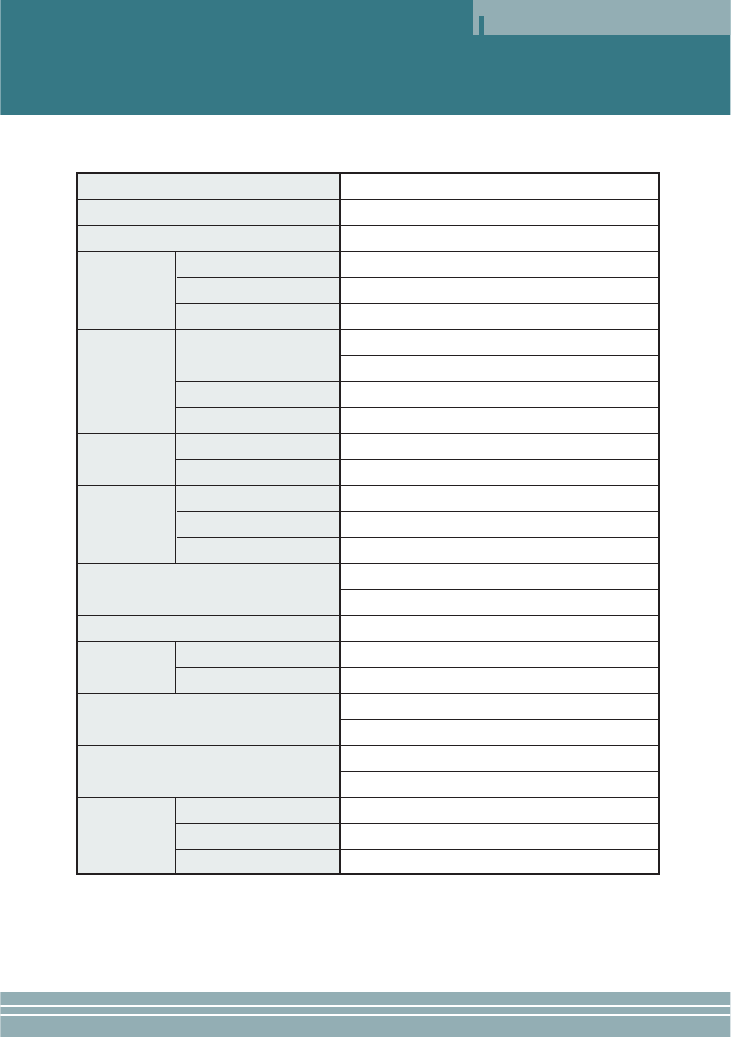
22
Specifications
Miscellaneous
Model
Size (Wx D x H)
Weight
Frequency characteristics
Audio Headphone output
S/N
Video
Supported files Audio
Image
Incoding
Video/Audio
Audio
Recording time ECONOMY
(based on the NORMAL
built-in memory) FINE
Picture display
PC connection
Memory type
Built-in
Extended
Battery use time
Power specification
Recommended OS
system CPU
specification Memory
DM-AV10
96mm x 79mm x 80mm
Including battery: 133g/Without battery: 107g
70Hz ~ 20KHz
20mW, Impedance: 16ohm
90dB or larger (based on MP3)
Direct playback: AVI (Video: ISO MPEG-4, Audio: MP3)
Trans S/W used: WMV, ASF, AVI, MPEG, MPG, WMA
MP3, ID3 Tag ver1.1
JPEG
MPEG-4/MP3, Extension = asf
MP3
100 minutes
55 minutes
30 minutes
3.5" Color TFT LCD, 480 x 240 Dot
NTSC/PAL (selectable)
USB 2.0
128MB FLASH MEMORY
SD card slot (8MB ~ 1GB)
Video playback: two hours
Audio playback: four hours (LCD OFF mode)
DC 5V 2.0A adaptor
DC 3.7V, 1100mA lithium ion battery
Windows ME/Windows 2000/Windows XP
Pentium III 500MHz at least
256MB
.
NOTE: This equipment has been tested and found to comply with the
limits for a Class B digital device, pursuant to part 15 of the FCC Rules.
These limits are designed to provide reasonable protection against
harmful interference in a residential installation. This equipment
generates, uses and can radiate radio frequency energy and, if not
installed and used in accordance with the instructions, may cause harmful
interference to radio communications. However, there is no guarantee
that interference will not occur in a particular installation. If this
equipment does cause harmful interference to radio or television
reception, which can be determined by turning the equipment off and on,
the user is encouraged to try to correct the interference by one or more
of the following measures:
- Reorient or relocate the receiving antenna.
- Increase the separation between the equipment and receiver.
-Connect the equipment into an outlet on a circuit different from that to
which the receiver is connected.
-Consult the dealer or an experienced radio/TV technician for help
THIS DEVICE COMPLIES WITH PART 15 OF THE FCC RULES.
OPERATION
IS SUBJECT TO THE FOLLOWING TWO CONDITIONS: (1) THIS DEVICE
MAY
NOT CAUSE HARMFUL INTERFERENCE, AND (2) THIS DEVICE MUST
ACCEPT ANY INTERFERENCE RECEIVED, INCLUDING INTERFERENCE
THAT MAY CAUSE UNDESIRED OPERATION.
THE MANUFACTURER IS NOT RESPONSIBLE FOR ANY RADIO OR TV
INTERFERENCE CAUSED BY UNAUTHORIZED MODIFICATIONS TO
THIS EQUIPMENT. SUCH MODIFICATIONS COULD VOID THE USER'S
AUTHORITY TO OPERATE THE EQUIPMENT